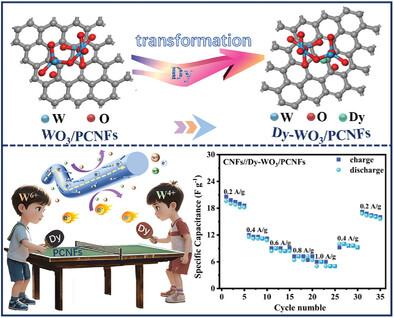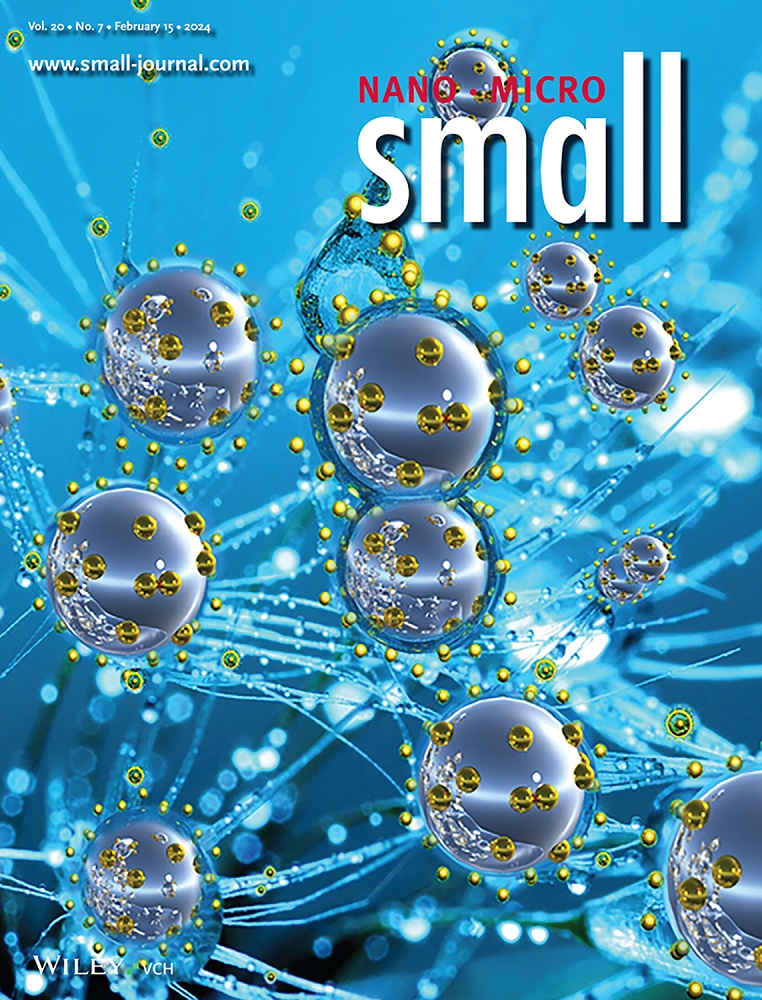Controlling of Crystal Facets by Dysprosium-Modified WO3/Carbon Nanofibers Enhance the Flexible Supercapacitor Performance
IF 13
2区 材料科学
Q1 CHEMISTRY, MULTIDISCIPLINARY
引用次数: 0
Abstract
Dysprosium-modified tungsten oxide/carbon nanofibers (Dy-WO3/PCNFs) are fabricated via electrospinning combined with high-temperature calcination to synthesize a flexible, self-supporting electrode material that does not require a conductive agent or binder. XRD and TEM analyses showed that introducing dysprosium promoted the preferential growth of WO3 crystals along the preponderance crystal planes involved in the electrochemical reaction, enhancing the exposure of the (002) and (200) crystal planes. Furthermore, DFT calculations demonstrated that the incorporation of Dy resulted in enhanced adsorption of Dy-WO3 by PCNFs, with an adsorption energy of −1.21 eV. The Bader charge results indicate a transfer of 1.70 |e| from PCNFs to Dy-WO3. DFT calculations demonstrate that strong adsorption facilitates charge adsorption/desorption, which contributes to charge transfer and enhances storage capacity. The prepared Dy-WO3/PCNFs exhibited a high specific capacitance (557.28 F g−1 at 0.5 A g−1). Supercapacitors assembled with Dy-WO3/PCNFs as the positive electrode and CNFs as the negative electrode have high energy density (29.8 Wh kg−1 at a power density of 363.48 W kg−1). This study demonstrates the successful synthesis of Dy-WO3/PCNFs with exceptional electrochemical properties and offers significant insights into the design and application of flexible electrodes by incorporating dysprosium to modulate the crystal surface of WO3.

用镝修饰的 WO3/碳纳米纤维控制晶体面,提高柔性超级电容器的性能
镝改性氧化钨/碳纳米纤维(Dy-WO3/PCNFs)是通过电纺丝结合高温煅烧的方法制造出来的,从而合成了一种无需导电剂或粘合剂的柔性自支撑电极材料。XRD 和 TEM 分析表明,镝的引入促进了 WO3 晶体沿着参与电化学反应的优势晶面优先生长,增加了 (002) 和 (200) 晶面的暴露。此外,DFT 计算表明,Dy 的加入增强了 PCNF 对 Dy-WO3 的吸附,吸附能为 -1.21 eV。巴德电荷结果表明,PCNFs 向 Dy-WO3 的电荷转移为 1.70 |e|。DFT 计算表明,强吸附有利于电荷的吸附/解吸,从而促进电荷转移并提高存储容量。制备的 Dy-WO3/PCNFs 具有很高的比电容(0.5 A g-1 时为 557.28 F g-1)。以 Dy-WO3/PCNFs 为正极、CNFs 为负极组装的超级电容器具有很高的能量密度(功率密度为 363.48 W kg-1 时为 29.8 Wh kg-1)。这项研究成功合成了具有优异电化学特性的 Dy-WO3/PCNFs,并通过加入镝来调节 WO3 晶体表面,为柔性电极的设计和应用提供了重要启示。
本文章由计算机程序翻译,如有差异,请以英文原文为准。
求助全文
约1分钟内获得全文
求助全文
来源期刊

Small
工程技术-材料科学:综合
CiteScore
17.70
自引率
3.80%
发文量
1830
审稿时长
2.1 months
期刊介绍:
Small serves as an exceptional platform for both experimental and theoretical studies in fundamental and applied interdisciplinary research at the nano- and microscale. The journal offers a compelling mix of peer-reviewed Research Articles, Reviews, Perspectives, and Comments.
With a remarkable 2022 Journal Impact Factor of 13.3 (Journal Citation Reports from Clarivate Analytics, 2023), Small remains among the top multidisciplinary journals, covering a wide range of topics at the interface of materials science, chemistry, physics, engineering, medicine, and biology.
Small's readership includes biochemists, biologists, biomedical scientists, chemists, engineers, information technologists, materials scientists, physicists, and theoreticians alike.
 求助内容:
求助内容: 应助结果提醒方式:
应助结果提醒方式:


